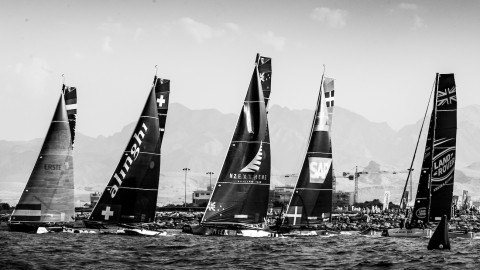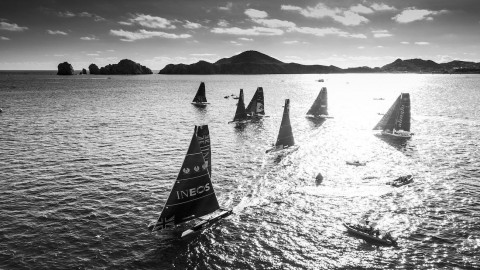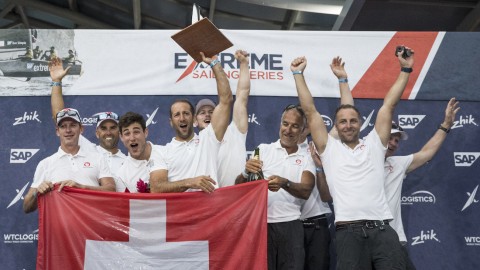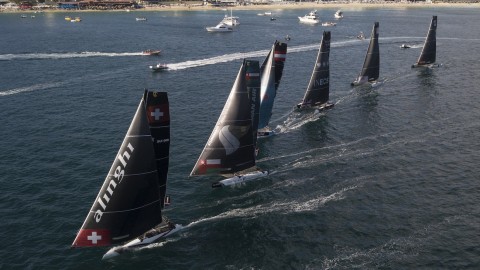Getting to know: Rasmus Køstner
Rasmus Køstner loves a challenge. After his best season to date with the SAP Extreme Sailing Team, Køstner and co-skipper Jes Gram-Hansen were the first to commit to the 2016 Extreme Sailing Series.
Friday 15th January 2016

Tristan Stedman
Rasmus Køstner loves a challenge. After his best season to date with the SAP Extreme Sailing Team, Køstner and co-skipper Jes Gram-Hansen were the first to commit to the 2016 Extreme Sailing Series. The Danish boys are relishing the new challenge of the GC32s as they continue their quest for a first championship win.
As we wait for the 2016 Extreme Sailing Series season to get underway, we caught up with Køstner at home in Denmark to talk about neuroscience, laughing at life and dreaming big.
There’s no better way to be with your family than being on a boat. I was a couple of days old when my parents first took me sailing. Being on the water is a big part of my whole family’s life and by the time I was born my parents had a 30-foot cruising yacht that we used for exploring the Swedish Archipelago.
My whole family sails, even my grandparents, but only my sister, Signe and I, race competitively. She won the Women’s Match Racing World Championship, which is something I haven’t achieved. The rest of my family just race each other for fun.
I always thought I would be a neuroscience researcher and it took some time before I accepted that sailing was what I was going to do. I studied molecular biology at Aarhus University but sailing always seemed to draw me away. I took time out during my masters when I was offered a position on the Italian Mascalzone Latino Team Capitalia, a challenger for the 32nd America’s Cup in Valencia, Spain.
The last 10 years have been an incredible journey. As friends growing up Jes and I got into professional sailing quite young through match racing. Back then that was that the direct route to the America’s Cup, but the industry suddenly changed. The boats got faster and multihull racing became a lot more serious. It wasn’t something that I had put a lot of time into. I’d only really sailed multihulls for fun with friends.
When we jumped on a catamaran to race for the first time it was clear there were a lot of lessons to be learned and I think that really motivated us. It has been fun trying to figure out what you can use from your previous experience and what doesn’t work. It’s very rewarding to feel like you’re learning every time you go sailing.
Monohulls, multihulls and foiling are worlds apart. Sometimes we laugh because we had an idea, a picture in our head of how we should do something, and afterwards - usually upside-down in the water - we realised we were so far off, all you can do is laugh.
We don’t have a big family fortune to invest in our sailing so we had to find commercial sponsorships to fund our campaigns. The America’s Cup is something special, it’s the pinnacle in many areas; the budgets, the teams, the technology. It is always going to hold its history and position in sailing but the Volvo Ocean Race and the Extreme Sailing Series offer the same opportunities for success for a professional sailor.
People often ask ‘what speeds are we doing?’ If you say to people “44mph” (39knots is the top speed of a foiling GC32), on a tiny aerofoil blade that works in the same way as an aeroplane wing, to lift the boat out of the water, it sounds amazing. They can relate to the speed and the dynamics of the boat.
The Extreme Sailing Series is part of a new direction in sailing. As the sport moves forward with foiling, the Series is going to revolutionise spectators’ understanding of what is happening on the water.
I couldn’t have done without Jes and that’s something that I’m extremely proud of, we were able to transform an idea into a real project and to realise a dream. It’s good to share some of the responsibilities, I don’t think people understand how big a task it is to establish, run and represent a team. So it’s nice to have somebody very close to you that you trust to discuss your problems and enjoy some of the victories with.
Sailing has taught me how to follow a dream. It is very rewarding chasing a dream for a long time and putting a lot of hours in. Sometimes maybe you have that feeling that it’s not going to happen but you still continue, you still keep working and then suddenly you make it. Everyone should have a dream and work hard to achieve it. It’s something that I have managed to do alongside some fantastic people.




